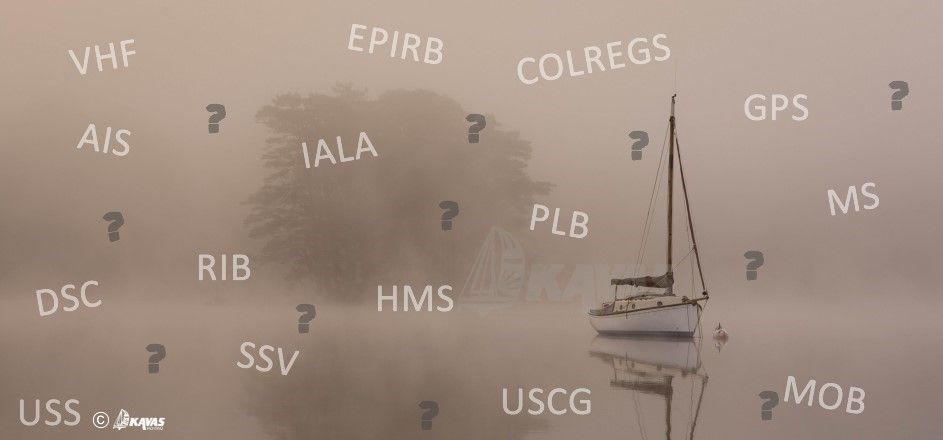The most commonly used abbreviations of the boating world
The yachting and boating world can seem strange to an outsider with all sorts of jargon and abbreviations. While most boaties are extremely welcoming, we can lose our landlubber friends by lapsing into jargon that makes our world opaque and confusing to newcomers and outsiders alike.
Over this article we will look at a selection of commonly used abbreviations and try to demystify some of the language used for your ordinary Jo or Joe at the dock. You may have just come back from a crewed yacht charter in Greece and may be thinking of learning more so you can bareboat charter in Greece next year? Hopefully here at Kavas Yachting we can demystify some of the language for you and make sailing a little easier to understand…
Safety
Safety at sea is full of acronyms that cover up what people are on about.
‘MOB’ stands for Man Overboard
you will more likely hear someone talking of an ‘MOB situation’ in a bar while when someone really goes over the side you will hear often less than polite, very loud language as the crew and skipper kick into action.
A ‘Dan buoy’ will go over the side – a floating flag to show a point close to the victim.
All children should wear ‘PFDs’ – personal flotation devices - as soon as the boat leaves the dock so they will more likely survive an MOB.
For any overnight trip, you should invest in Personal Locator Beacons (PLBs) that will send a radio signal as to the wearer’s exact location to the boat.
At night or in fog this will give a greater hope of rescue.
All vessels doing more than a few hours on a day sail should carry an ‘EPIRB’ – an Emergency Position Indicating Radio Beacon that will fire up as soon as it is immersed in the water.
If the boat sinks suddenly and no one has managed to get on the Very High Frequency (VHF) radio to call the Coast Guard the EPIRB will let the emergency services know what’s happening.
EPIRBs are given position data by a Global Positioning System (GPS) receiver that calculates your exact point on the planet by triangulating your position relative to up to eight satellites in space.
Navigation
We’ve briefly looked at GPS. Most people will have a GPS for their Satnavs in their cars, but are invaluable for boating as there are few road signs at sea!
IALA is the International Association of Lighthouse Authorities. They have agreements as to exactly what each navigation mark should look like, the meanings of the colours of lights and shapes, as well as the way each light should flash.
In following these you can triangulate your position using a hand compass and not, for example, hit a wreck that the buoy is there to warn you about. If you want to learn navigation you would do well by doing a Royal Yachting Association (RYA) ASA (American Sailing Association), or your nationally accredited sailing organisation’s qualifications.
We also looked at VHF above. This has another wealth of abbreviations that you will learn when you do your VHF course through an accredited training provider. They have DSC (Digital Selective Calling) that allows easier emergency calling to the emergency services.
Automatic Identification System (AIS) is a GPS radio beacon that shows up on digital charts, detailing what a vessel is and where it is headed.
In fog or at night you will be able to tell whether a radar (Radio Detection And Ranging) signal is a lobster pot or a super tanker using AIS…
To avoid hitting other boats, or being hit by them, you should obey the COLREGS (Collision Regulations) that are a form of international law of the sea as to who should avoid whom and how.
Do a night school course to learn more!
Types of boat
One of the most common vessels you will hear about are Rigid Inflatable Boats (RIBs). These are motor boats that have fiberglass hulls with inflatable rims. These are almost unsinkable, can be very quick, and are very good workboats which is why you see so many on the water. The coast guards sometimes use Inshore Rescue Boats (IRBs) for shallow waters. These tend to be RIBs.
You may see a tall ship with the abbreviation SSV before its name. This stands for Sail School Vessel. Most tall ships on US waters are registered as sailing schools. They are very rarely ‘MS’ – Motor Ships – that tend to be merchant ships.
USS stands for United States Ship, and tend to be military though can include rescue boats run by the USCG.
You may from time to time see a UK Royal Navy ship in Greek waters (perhaps picking up refugees on their way from the Middle East) whose prefix is HMS – Her Majesty’s Ship, as Queen Elizabeth owns it.
Overall?
Boating is a career, much as your employment in banking or business is. Each career has a wealth of jargon and abbreviations that demarcate your place in the world.
While boaties’ language can be opaque and unfamiliar it is shorthand so your seafaring folks understand you the better. It isn’t about erecting walls against outsiders.
On the whole we’ll happily explain what we’re on about – just ask!
Alternatively, sign up for a sailing course this winter and learn formally – and you may well be able to take a Kavas yacht sailing next year, comfortable in the knowledge you can talk the talk, if not walk the walk…

See also ↠ Troubleshooting, Sailing qualifications


